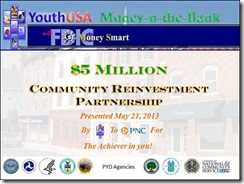
By Stephanie and Eric Stradford
AMWS June 13, 2013, Atlanta -- Five years after America’s most recent financial crisis peaked, Washington is getting around to studying some lingering effects. What happens when historic social problems are repeatedly swept under the rug? What have we learned from 19th, 20th and 21st Century financial disasters?
Where are we now? Did the bloody Civil War to preserve a slave system that sustained America’s financial industries (human trafficking, farming, construction, railroads, hospitality, and much more) bring about “justice for all?” As the nation seeks wisdom of the courts on voting rights and affirmative action, too many have yet to recover from historically unlawful and or unethical practices that continue to threaten American lives.
What are the prospects for meaningful reform of the American Values system? Will our $16 trillion debt crush us? Should we let it? Is it legitimate? What comes next? Questions posed by the American Scholar and others point to a broken system that has been economically measured, “Too Big to Fail and Too Risky to Exist.”
Some of the same bad habits feeding Wall Street’s 2008 meltdown seem to have been evident in the behavioral economics of 1929. In both failures, we might have at least learned to PAY ATTENTION. But since we didn’t increase our own interest in America’s money in the bank, we lost value in our obligations to community reinvestment.
By now, most of us know about the “Cradle to Prison Pipeline.” The Children’s Defense Fund, founded by Marian Wright Edelman, describes this particular problem as a threat to America’s national security. However, public policy professionals continue to package the problem in social terms. In any case, the U.S. Senate offers a 2 hour 22 minute and 48 second discussion to help you get your head around it.
We are told that The Federal Reserve Bank dug up $9 trillion to make short term loans through some 21,000 transactions. The Fed’s action in September 2008 followed the implosion of investment bank Lehman Brothers. Not one of the 21,000 transactions can be traced to the long term effects of investing too much in America’s prisons and too little in American children.
The question “How long?” festers in the wounded spirit of the nation’s have-nots and can add value to America’s vision of its own future. In almost every situation where “We The People” as “One Nation Under God” applied “ICAN,” we did.
The Wall Street Crash of 1929, known as Black Tuesday, and the Stock Market Crash of 1929 is arguably the most devastating stock market crash in the history of the United States. The crash signaled the beginning of the 10-year Great Depression that affected all Western industrialized countries and did not end in the United States until the onset of American mobilization for World War II. That historic event followed a credible threat to America’s national security at the end of 1941.
In 1989, the CEOs of our seven largest banks earned an average of $2.6 million. In 2007, the average CEO income had risen to $26 million. The ordinary citizen might believe that this is grotesque overcompensation, but the financial sector found the pay perfectly reasonable. This credible threat to economic security is known as a “golden parachute,” an employment contract or agreement guaranteeing a key executive substantial financial benefits in the event of job loss caused by the company's being sold or merged.
The late Arthur A. Fletcher, an assistant U.S. Labor Secretary in the Nixon administration, and Father of the Affirmative Action Enforcement Movement, alerted advocates to ways and means for holding banks, treasury and labor officials accountable to the 1977 Community Reinvestment Act. Fletcher introduced some “Friends of America’s Future” to the Community Development Financial Institutions Fund. His economic ministry provided technical assistance to historically disadvantaged students, small businesses, and even some community bank executives he characterized as “the spook by the door.”
Fletcher and others saw the crisis as a cultural failure combined with a political collapse. Behavior by bank executives that once was discouraged by a lifted eyebrow created complex structures abetted by an aggressive reading of the statutes—anything not explicitly prohibited was considered permissible. So, theoretically, any plan for community reinvestment within the law, is a plan worth taking to the bank.
Not necessarily so, too many displaced bank executives consider their past failures as a plus on their resumes. Too many bank personnel are uninformed or disinterested about what they can do to engage Americans in community reinvestment. In the words of former First Lady Nancy Reagan, they just say no. The institution formerly known as Wachovia Bank found it all too easy to say no. Its own history, habits and toxic assets lead to its 21st Century demise.
On its way out, Wachovia responded to allegations of bad banking with a report on 19 financial institutions and money banked by slave owners. Some of the institutions, researched by The History Factory, likely profited from slavery through their many investments in banks based in slave states. Two of the three founders of the Bank of North America, Robert Morris (the bank’s first president) and Thomas Willing, amassed at least part of their personal fortunes from the slave trade. In 1781, they formed Willing & Morris, a Philadelphia-based merchant business that dealt significantly in slave shipments and trading. Both Willing and Morris used their profits from the slave trade to fund the establishment of the Bank of North America.
In 2000, Congress started to address economic fallout such as redlining, predatory lending and non-compliance with the 1977 Community Reinvestment Act. The New Markets Tax Credit Program (NMTC Program) was established to spur new or increased investments into operating businesses and real estate projects located in low-income communities.
Since the NMTC Program's inception, the CDFI Fund has made 749 awards allocating a total of $36.5 billion in tax credit authority through a competitive application process. This $36.5 billion includes $3 billion in Recovery Act Awards and $1 billion of special allocation authority to be used for the recovery and redevelopment of the Gulf Opportunity Zone.
Current First Lady Michelle Obama has been out front in the transformation of an economic security issue that used to be a social concern. In 2011, Treasury invested $25 million in grants for The Healthy Food Financing Initiative (HFFI). Through a range of programs at the U.S. Departments of Agriculture (USDA), Treasury, and Health and Human Services (HHS), HFFI expands the availability of nutritious food, including developing and equipping grocery stores, small retailers, corner stores, and farmers markets selling healthy food.
The latest chance to win a chance to win with grassroots community reinvestment identifies PNC Bank as the applicant for a Bank Enterprise Award. The U.S. Treasury program identifies public funds to encourage investments in non-real estate businesses for working capital and equipment. The Internal Revenue Service (IRS) issued final regulations (Treasury Decision 9600) modifying reinvestment requirements under the New Markets Tax Credit (NMTC) Program.
One community bank executive perhaps did not get the corporate memo about what to do when America’s Future calls. “Thanks, I got your information and when you all have a specific project with ALL of the supporting information that we can evaluate and make a decision, I will get back to you with our response.” The bank executive’s 10 minute tongue lashing followed up on a two hour briefing with his associate. The associate leisurely took two weeks to “get my head around the idea.”
Phil Angelides, chairman of the U.S. Financial Crisis Inquiry Commission, summarized the problem: “These banks are too big to fail. They’re too big to manage. They’re too big to regulate. They’re too complex to understand and they’re too risky to exist. And the bottom line is they offer very little benefit.”
Discussion of a full proposal that funds counter terror operations responding to Cradle To Prison Pipeline calls for vision such as that communicated by James E. Rohr, Executive Chairman, The PNC Financial Services Group. “A business cannot succeed if its communities are not well positioned for future growth and success. That is why at our bank we devote resources and human capital to seed ideas, foster development initiatives and support nonprofit organizations.” To date, neither bank employee has added value to the stated corporate vision.
Rarely is there a frank discussion of the legitimacy of the debt. It seems that debt, prefaced by, “In the interest of national security,” is necessary debt. As Mervyn King, governor of the Bank of England, put it, “There was a cultural tendency to be always on one side and always to be pushing the limits.” The crisis almost immediately destroyed the rule of law.
Secretary of the Treasury Henry Paulson told The Washington Post in November 2008: “Even if you don’t have the authorities—and frankly I didn’t have the authorities for anything—if you take charge, people will follow. Someone has to pull it all together.”
